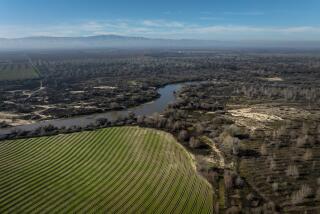Lessons of ‘Next Time’ Sink In After Floods : Midwest: Towns with levees are thankful. But in unprotected cities, debates over disaster plans intensify.
KANSAS CITY — Jay Dillingham lived long enough to help save his city the second time.
In 1951, the year the Kansas and Missouri rivers flooded here and caused more than a million dollars in damage, Dillingham, then 41, and his contemporaries vowed that it would never happen again.
They launched a grass-roots campaign to build a levee that would hold off the next major flood. And when the impressive Kansas City levee was finished several years later, it stretched 20 miles long and stood 55 feet high.
It was built out of dirt and concrete, and for the next four decades stood unused and untested. It even got to the point where some city officials cackled and called it “Jay’s Folly.”
But on July 27, when the flooded Missouri and Kansas rivers converged and crested again in Kansas City, the water only came within four feet of the top of the new levee. The city was saved.
“There were some people who said it wouldn’t work, but heck, I remember people who said the airplane wouldn’t fly either,” said Dillingham, now 83 and the retired president of the Kansas City Stockyards Co.
“Our levee had never been tested before, but it was sure tested this time and it sure worked. I don’t know how many in lives and damages it saved, but for us it was a godsend.”
All across the Midwest, as rain clouds move out and swollen rivers recede, local officials are looking back at the lessons they learned or missed over the last four decades.
Did their expensive flood protection systems hold up? Were they wrong in gambling that a major flood was far off in the future? How do they prepare now for what tomorrow’s clouds might bring?
One thing is clear already: No matter how high or how sturdy, many of the levees affected by the flood had to be shored up with millions of sandbags as the waters raged ever higher. In other words, as the crisis hit, no one felt protected enough.
“It takes almost a major disaster to get us thinking again,” said Michael Klingner, secretary of the Upper Mississippi Flood Control Assn., a group of private and public flood control organizations. “And that’s what we hope will come out of this flood.”
But other cities, even now reeling from extensive flooding this summer, still defend their decisions in past years not to build levee protection.
“Iowa had some hard times in the ‘80s,” said Jo Ann Strack, of the League of Iowa Municipalities in Des Moines. “It was hard politically to say you were going to go out and build a levee for a once-in-a-hundred-years flood when your constituents wanted other things that cities do, like more police and fire protection.”
In past years, following major floods beginning in the late 1940s, some cities built new levees or shored up old ones. Some relocated their downtowns and business districts away from the flood plains.
Many of them were spared major damages in the Great Flood of ’93.
But other cities, stubborn or unable to raise the voter support or venture capital, did little or nothing to protect themselves for the water next time. And they suffered.
In the Quad Cities area along the upper Mississippi River separating Iowa and Illinois, for example, the local options ran the gamut.
Rock Island, Ill., with 650 acres of industrial, commercial and residential land subject to flooding from the Mississippi River, built a set of drainage structures and levees that were completed in 1974.
The project staved off major disaster last month, a point not lost on city officials as they look across the river and see what happened in Davenport, Iowa.
“I’m glad our forefathers had the foresight to build this,” said John Phillips, the city manager in Rock Island. “It’s sure made my life a lot easier.”
In Davenport, where officials built nothing, choosing instead to preserve their panoramic view of the Mississippi River, the mayor has estimated that the city suffered up to $100 million in flood damages, lost income and cleanup costs.
Even the city’s new gambling showboat, the President, was damaged and taken out of commission, while across the river the Casino Rock Island not only stayed in operation but picked up all of the President’s business. “It was one of the best weeks we’ve ever had,” boasted Phillips.
Despite the stark differences, city officials in Davenport do not appear in any hurry to build a river levee that would obstruct their view of the Mississippi.
Three times in the past, bond proposals for a levee came before the City Council, and three times they failed. Davenport tourism, city officials said, is not to be tampered with.
“One of the top five things foreign visitors want to see in America is the Mississippi River,” said Larry d’Autremont, a Davenport alderman. “They want to read about Mark Twain and Tom Sawyer, and we want them to come to Davenport.”
Even after this summer’s flooding, d’Autremont said he still does not think a levee proposal would be approved in Davenport. He does not believe the people of Davenport will be pushed into something that alters their life on the Mississippi.
“The mood of the town today is sort of like nervous cattle,” the alderman said. “But we will not be stampeded into separating ourselves from the river by a wall.”
Dee Bruemmer, assistant city administrator, was just as stubborn. “There’s going to be a healthy community debate about what to do next. We’ll be looking around at how other communities did. But I still don’t think we will block out the river.”
Davenport was not alone, either.
Dillingham recalled that while Kansas City’s levee was sitting idle all those years, Pattonsburg, Mo., considered building a dam that would have created a recreational lake and, more importantly, protected thousands of acres of farmland downstream.
“But the natives didn’t want it, and they fought it like hell,” Dillingham said. “Since then, they built a highway through there, and now you can’t do any dam work. And every year they have a flood with the spring rains, and this year they got it real bad.”
In nearby St. Joseph, Mo., the U.S. Army Corps of Engineers worked up three feasibility studies for protection from flash floods in tributaries that flow through the city. Three bond proposals were put to the voters, and the voters turned them down each time.
Last month, when the Missouri flooded, parts of St. Joseph had to be evacuated.
“The city leadership had wanted to proceed, but they couldn’t, and they were left very, very vulnerable,” said Michael Bart, assistant chief of engineering for the Kansas City district of the Army Corps.
And in Des Moines, where 250,000 residents were left without water when the Raccoon River flooded the city’s water treatment plant, officials now realize they must either move the plant to higher ground or build a much higher levee around it.
“Our board has got a lot of discussing to do,” said Carla West, administrative coordinator for the Des Moines Water Works.
Klingner of the Upper Mississippi Flood Control Assn. predicted that pressure will be intense on Washington in the coming months for more flood protection programs.
In the past, the federal government has financed up to 80% of the costs for new levees, with the remainder borne by local jurisdictions. But the association plans to lobby for even more federal financing as the Midwest digs itself out of the flood debris.
“These projects don’t come easy,” he said. “You have to stack up all the federal and state assistance you can get.”
And in Kansas City, Dillingham marvels at how some cities still don’t or won’t protect themselves from floods. He has seen two river crests roar past his hometown: The first caused extensive damage to the city’s industrial base, the second never got over the new flood wall.
Looking at cities like Davenport, he speaks from experience when he says: “I think they better build a levee.”
More to Read
Sign up for Essential California
The most important California stories and recommendations in your inbox every morning.
You may occasionally receive promotional content from the Los Angeles Times.











